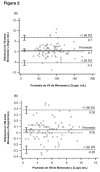[Validation of a new impedance cardiography device for noninvasive hemodynamic measurement in outpatient hypertensive patients]
- PMID: 40163829
- PMCID: PMC12057702
- DOI: 10.31053/1853.0605.v82.n1.45253
[Validation of a new impedance cardiography device for noninvasive hemodynamic measurement in outpatient hypertensive patients]
Abstract
Objective: To compare the new cardiograph ZLogic for non-invasive measurements of Stroke volume (SV) and Cardiac output (CO) against the Minnesota cardiograph.
Methods: 86 subjects from both genders, 18-80 years old, hypertensive and healthy volunteers were included. Three hemodynamic measurements performed with each device, in an alternate fashion, using the Bland-Altman method to determine the level of agreement. Percentage error was calculated for interchangeability of both methods.
Results: Mean SV was 86.71±27.35 mL and mean CO 5.42±1.74 L/min. There was a strong correlation between measures of SV and CO obtained with both devices (r=0.99, p<0.001). Mean difference (MD) for SV was 0.65±3.08 mL (CI95%: -0.01-1.31) and 95% limits of agreement −5.39 to +6.69 mL. MD for CO was 0.05±0.17 L/min (CI95%: 0.01-0.09) and the 95% limits of agreement −0.28 to +0.38 L/min.
Conclusion: ZLogic and Minnesota cardiographs provided equivalent SV and CO values in ambulatory hypertensive patients.
Objetivo: Comparar las estimaciones no invasivas de volumen sistólico (VS) y volumen minuto (VM) obtenidas por un nuevo cardiógrafo (ZLogic) y por un cardiógrafo de referencia (Minnesota).
Métodos: Se incluyeron 86 sujetos de ambos sexos, de 18 a 80 años, hipertensos y voluntarios sanos. Se realizaron tres mediciones hemodinámicas con cada aparato, de forma alternativa, utilizando el método Bland-Altman para determinar el nivel de acuerdo. Se calculó un porcentaje de error para la intercambiabilidad de ambos métodos.
Resultados: La media de VS fue de 86,71±27,35 mL y la media de VM 5,42±1,74 L/min. Hubo una fuerte correlación entre las medidas de VS y VM obtenidas con ambos dispositivos (r=0,99, p<0,001). La diferencia media (DM) para la VS fue de 0,65±3,08 mL (IC95%: -0,01-1,31) y los límites de acuerdo del 95% -5,39 a +6,69 mL. La DM para el VM fue de 0,05±0,17 L/min (IC95%: 0,01-0,09) y los límites de acuerdo del 95% -0,28 a +0,38 L/min.
Conclusión: Los cardiógrafos de ZLogic y Minnesota proporcionaron valores equivalentes de VS y CO en pacientes hipertensos ambulatorios.
Keywords: impedance cardiography; stroke volumen; cardiac output; hypertension.
Universidad Nacional de Córdoba
Conflict of interest statement
Ninguno.
Figures
References
-
- Medina-Lezama J, Narvaez-Guerra O, Herrera- Enriquez K, Morey-Vargas OL, Bolaños-Salazar JF, Abugattas JP, Zea-Diaz H, Chirinos-Revilla JL, Fernandez-Sivincha JG, Delgado-Lazo V, Chirinos DA, Townsend RR, Chirinos JA. Hemodynamic Patterns Identified by Impedance Cardiography Predict Mortality in the General Population: The PREVENCION Study. J Am Heart Assoc. 2018 Sep 18;7(18):e009259. doi: 10.1161/JAHA.118.009259. - DOI - PMC - PubMed
-
- Rada MA, Cuffaro PE, Galarza CR, Barochiner J, Alfie J, Posadas Martinez ML, Giunta DH, Morales MS, Aparicio LS, Waisman GD. Predictive value of non-invasive hemodynamic measurement by means of impedance cardiography in hypertensive subjects older than 50 years of age. Clin Exp Hypertens. 2014;36(5):280–4. doi: 10.3109/10641963.2013.810232. - DOI - PubMed
-
- Talvik A, Rebora P, Heinpalu-Kuum M, Salerno S, Miszkowska-Nagórna E, Liu X, Comotti T, Świerblewska E, Valsecchi MG, Fadl Elmula FEM, Larstorp AC, Narkiewicz K, Parati G, Laurent S, Viigimaa M, BEtter control of blood pressure in hypertensive pAtients monitored Using the hoTman® sYstem (BEAUTY) Study Investigators Non-invasive hemodynamic monitoring as a guide to drug treatment of uncontrolled hypertensive patients: effects on home blood pressure in the BEAUTY study. Blood Press. 2018 Dec;27(6):368–375. doi: 10.1080/08037051.2018.1505425. - DOI - PubMed
Publication types
MeSH terms
LinkOut - more resources
Full Text Sources
Medical


